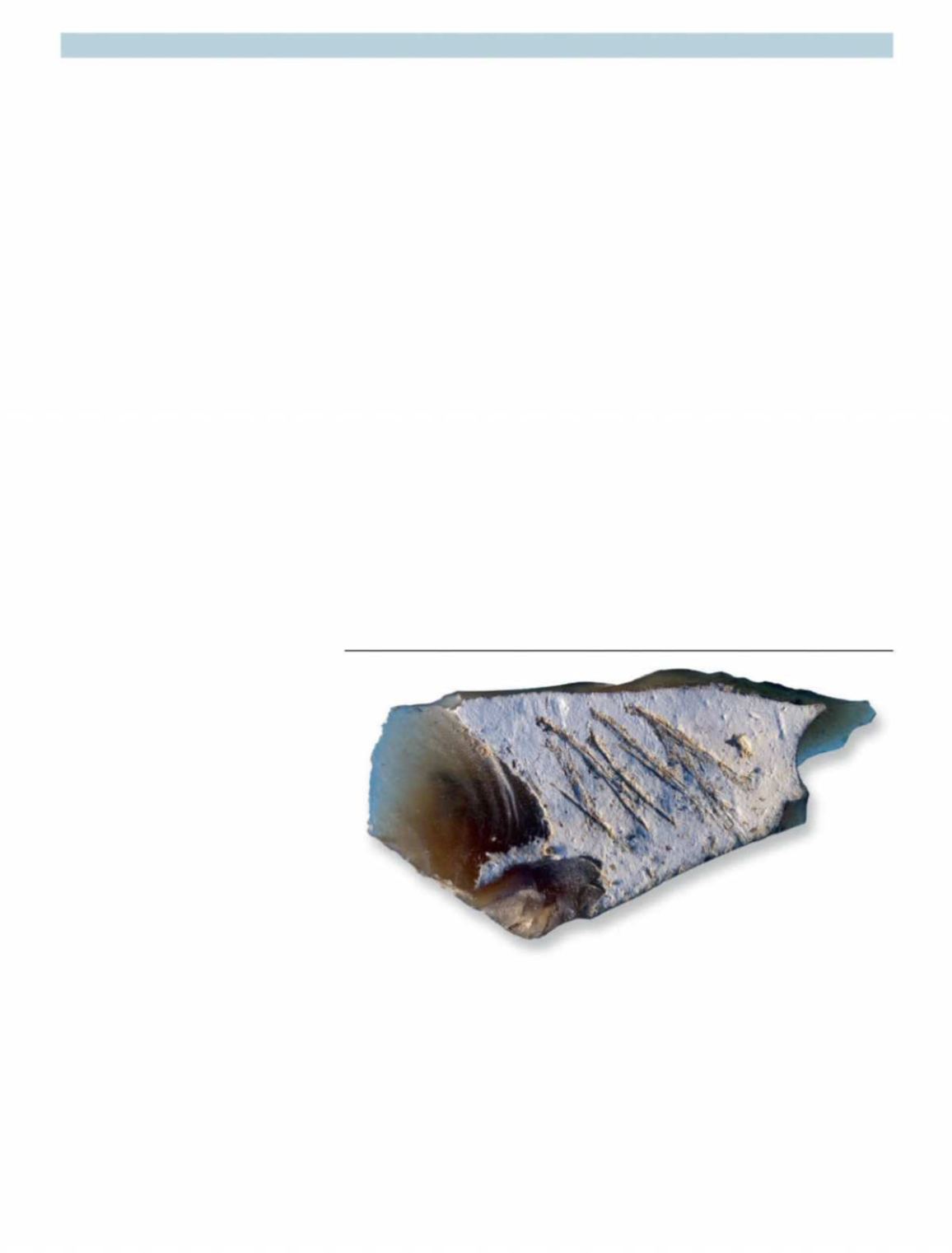
The scratches on this flake of flint may not look much but they were made with
deliberation by a Neanderthal man or woman. That is the conclusion of Ana Majkic of the
University of Bordeaux and her colleagues, in a paper just published in
PLOS ONE
.
Dr
Majkic’s analysis bears on the question of whether Neanderthals had anything that might
remotely be described as an artistic impulse—a phenomenon many anthropologists
suspect is unique to
Homo sapiens
. The stone in question, about 4cm long, was found in
1925 (though no description of it was published until 2006) in a cave in the Crimea that
also played host to Neanderthal bones. Patterns of scratches on stones used by
Neanderthals are not unusual. They have been found at more than two dozen sites. But
whether those patterns are deliberate or accidental is much debated. Dr Majkic argues for
deliberation in this case because microscopic examination suggests the scratches were
made by two different engraving tools, and also because, despite the flint being small,
the pattern on it is framed by an unscratched area. If the scratches were accidental, some
of them would probably reach the edge.
But is it art?
76 Science and technology
The Economist
May 5th 2018
1
D
IPLOMATS theworldover knowthat a
well-chosen turn of phrase can make
or break a negotiation. But the psycholog-
ical effects of different grammatical struc-
tures have not been investigated as thor-
oughly as they might have been. A study
just published in
Psychological Science
, by
Michal Reifen-Tagar and Orly Idan, two re-
searchers at the Interdisciplinary Centre
Herzliya, in Israel, has thrown some light
on the matter. Dr Reifen-Tagar and Dr Idan
have confirmed that a goodway to use lan-
guage to reduce tension is to rely, whenev-
er possible, on nouns rather than verbs.
Dr Idan, a psycholinguist, knew from
previous work that the use of an adjective
instead of a noun in a sentence (“Jewish”
rather than “Jew”, for example) can shape
both judgment and behaviour. Likewise,
Dr Reifen-Tagar, a social psychologist,
knew from her own earlier research that
successful diplomacy often hinges on
managing anger in negotiatingparties. Put-
ting their heads together, they suspected
that employing nouns (“I am in favour of
the removal of settlers”), rather than verbs
(“I am in favour of removing settlers”), to
convey support for policy positionswould
have a calming effect. The one is more like
a statement of an abstract belief. The other
ismore like a prescription of a course of ac-
tion and is thus, they hypothesised, more
likely to arouse emotions.
To test this idea they recruited 129 Jew-
ish-Israeli college students and presented
themwith statements about policies asso-
ciated with the Israeli-Palestinian conflict.
Specifically, these statements concerned Is-
raeli concessions on matters like the re-
lease of Palestinian prisoners, the borders
of Israel, the return to Israel of Palestinian
refugees and the division of Jerusalem.
Half of the statements were given in
noun form (“I support the division of Jeru-
salem”). The other half were given in verb
form (“I support dividing Jerusalem”). Par-
ticipants responded to each on a six-point
scale, where a value of one indicated “I to-
tally disagree” and a value of six indicated
“I totally agree.” All of the statements were
in Hebrew, in which such sentence struc-
tures are natural and acceptable. After each
statement was given, participants were
asked to indicate, also on a six-point scale,
the extent to which they would feel anger
towards the state of Israel if the concession
in questionwere actually granted.
As the researchers had hypothesised,
presenting the statements in noun form re-
duced feelings of anger. Participants so
treated had an average anger score of 3.21,
in contrast to the 3.67 averaged by those
presentedwith verb-form statements. This
is a statistically significant difference. The
noun forms of the statements also in-
creased support for the concessions, with
these scores averaging 2.02, in contrast to
the average of 1.72 scored by participants
presentedwith verb-form statements.
Given these results, Dr Reifen-Tagar and
Dr Idan wondered whether the reduced
anger induced by the noun form would
translate into reduced support for hostile
action toward Palestinians. They therefore
ran the experiment again, having recruited
270 new participants, with additional
statements like “I am in favour of demol-
ishing/the demolition of homes belonging
to familymembers ofthose involved in ter-
rorist activities” and “of cutting off/the cut-
ting offof supply of electricity to Gaza dur-
ingwartime”.
The results were much the same as
those in the earlier experiment. Partici-
pants given the noun-structure statements
again showed notably more support for
concessions. But they also showed much
less enthusiasm for retaliatory policies,
with an average score of 2.92 compared
with the 3.91 averaged by those given verb-
structure statements. Inmatters of conflict,
as in somanyother areas oflife, it turns out
that presentation is everything.
7
Language
Manners of
speaking
Science looks at the subtleties
of semiotics
A
LAN TURING was no slouch. He laid
the mathematical groundwork for
modern computing. He led the successful
effort to crack Germany’s Enigma code
during the second world war. And he also,
though it is less well known, made an im-
portant contribution to chemistry with a
paper winningly entitled “The chemical
basis ofmorphogenesis”. In it he described
howthe diffusion of two chemicals that re-
act with each other can, in certain circum-
stances, produce complex patterns of
blobs and striations. These patterns, now
called “Turing structures”, bear an uncan-
ny resemblance to many that are found in
nature: a zebra’s stripes, for example, or a
ladybird’s spots.
The extent to which such processes are
involved in the embryonic development
of animals is debated. But, on a more prac-
tical note, ZhangLinofZhejiangUniversity
in Hangzhou, China, and his colleagues
now hope to turn Turing’s chemical in-
sights to the task of improving desalina-
Chemistry
Howdesalination
got its stripes
Amembrane that can remove salts from
watermore efficiently
РЕЛИЗ ПОДГОТОВИЛА ГРУППА "What's News"
VK.COM/WSNWS







